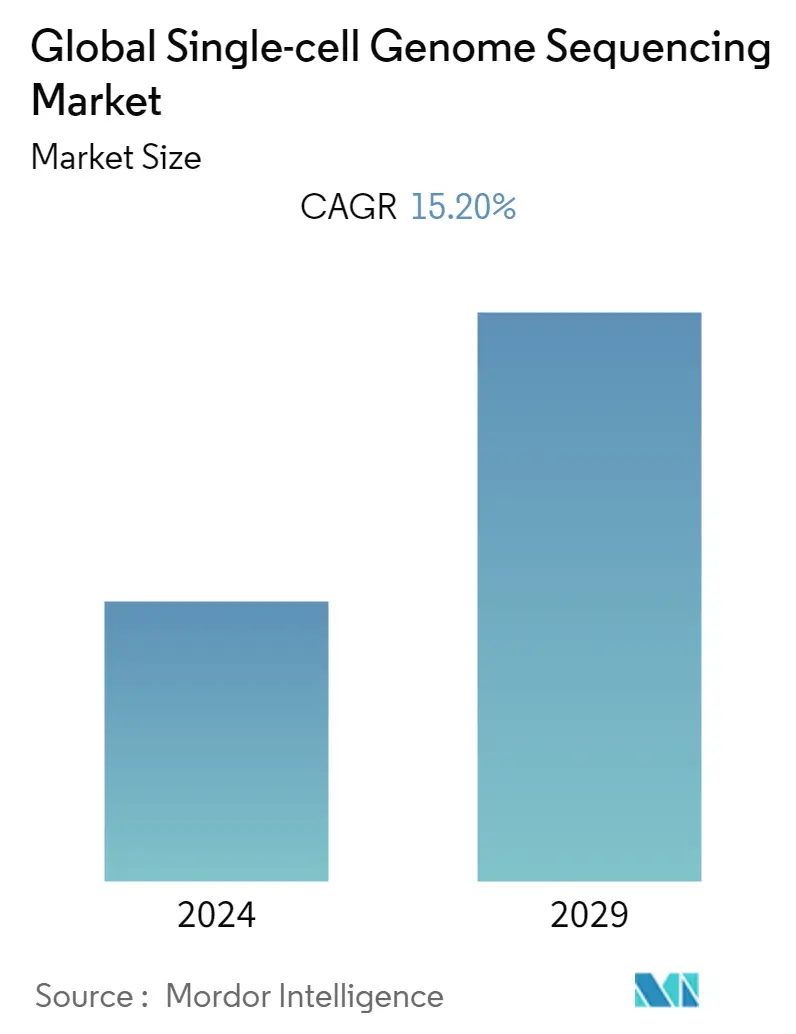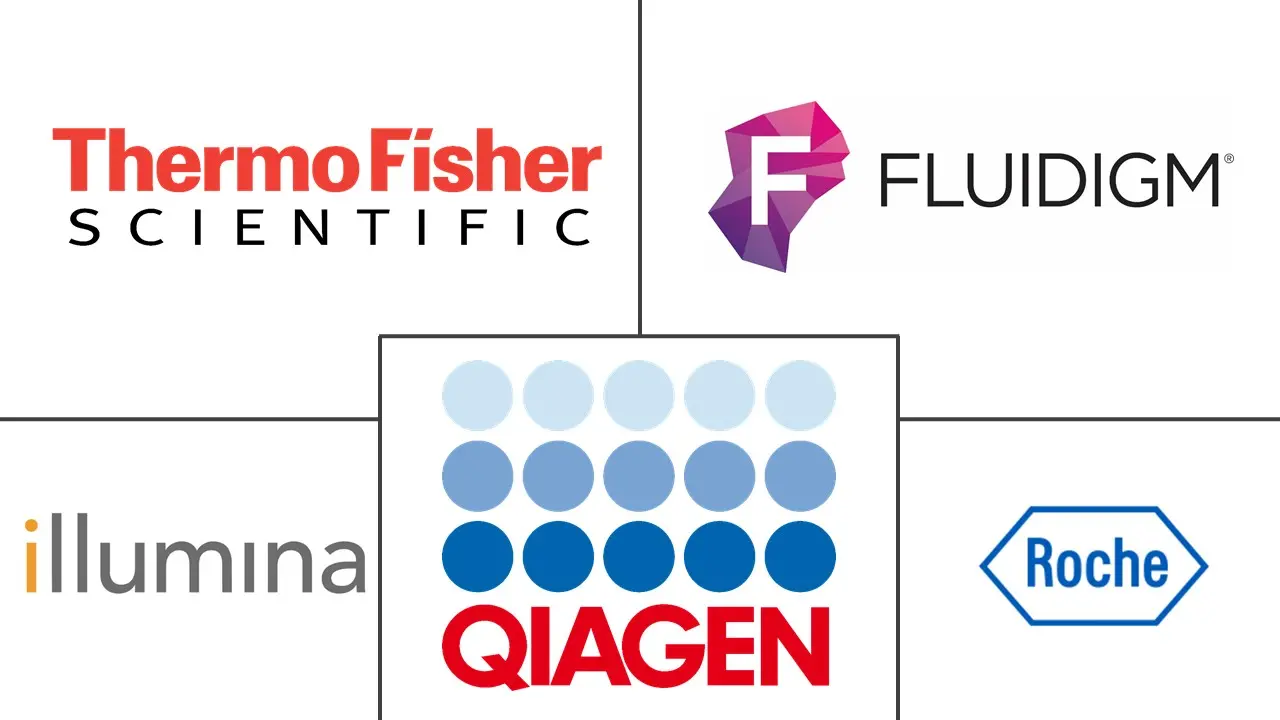Market Size of Global Single-cell Genome Sequencing Industry

| Study Period | 2019 - 2029 |
| Base Year For Estimation | 2023 |
| Forecast Data Period | 2024 - 2029 |
| CAGR | 15.20 % |
| Fastest Growing Market | Asia-Pacific |
| Largest Market | North America |
Major Players
*Disclaimer: Major Players sorted in no particular order |
Single-cell Genome Sequencing Market Analysis
The Single-cell Genome Sequencing Market is projected to register a CAGR of 15.2% during the forecast period 2022-2027.
The COVID-19 pandemic had a positive effect on the studied market. Various research studies have been published about the impact of COVID-19 on single-cell sequencing. For Instance, in September 2020, research published titled 'Single-cell landscape of Immunological Responses in Patients with COVID-19' stated that coronavirus disease (COVID-19), caused by severe acute respiratory syndrome coronavirus 2 (SARS-CoV-2) infection, the relationship between disease severity and the host immune response is not fully understood. When single-cell sequencing was performed, most cell types in patients with COVID-19 showed a strong interferon-α response and an overall acute inflammatory response. Such studies provide inside into the application of single-cell sequencing on COVID-19. Similarly, in February 2022, another research study titled 'Integrating Single-Cell Sequencing Data with GWAS Summary Statistics Reveals CD16+ Monocytes and Memory CD8+T Cells Involved in Severe COVID-19' stated that there was a major genetics-modulated immunological shift between mild and severe infection, including an elevated expression of genetics-risk genes, increase in inflammatory cytokines, and of functional immune cell subsets aggravating disease severity, which provides novel insights into parsing the host genetic determinants that influence peripheral immune cells in severe COVID-19. Hence, such studies provide insight into COVID-19 and thus increase the market growth in the future.
Factors such as increasing diseases, initiatives by key market players, and increased funding are expected to increase the market growth. Rising disease prevalence is also likely to boost the drug development processes in the region, ultimately leading to the studied market expansion owing to the benefits offered by the devices. For Instance, as per the article titled ' United States Tax Dollars Funded Every New Pharmaceutical in the Last Decade' published in September 2020 2.2 million published research related to the biological drugs or targets of which 21% acknowledged funding from National Institutes of Health (NIH) of more than than USD 230 Billion. Such funding in the biotechnology field increases the research and the usage of PCR devices (including single-cell sequencing), boosting the market's growth. The collaboration among the market players and research institutes for the research and development of new diagnostics and treatment methods with the help of the sequencing method is also boosting the market's growth. For Instance, in January 2020, Illumina and Israel-based Danyel Biotech reported that scientists at the Weizmann Institute of Science in Israel are now using Illumina's next-generation sequencing (NGS) technology. Weizmann has been a pioneer of single-cell genomics, and Illumina's technology will enable the Institute's researchers to continue advancing this fast-growing field of research. The newly-installed system also expands genomic research capacity within Israel. The institutes are using NovaSeq 6000 system to investigate how cells within the immune system interact with healthy tissue and tumor cells. Since the use of NovaSeq 6000 enables researchers to sequence the genome, epigenome, and transcriptome (RNA sequence), it is expected to drive the growth of the studied market. Thus, due to the abovementioned factors, the market is likely to grow in the future.
However, analytical challenges related to single-cell genome sequencing will hinder the market's growth.
Single-cell Genome Sequencing Industry Segmentation
According to the scope, single-cell genome sequencing involves isolating a single cell, performing whole-genome-amplification (WGA), constructing sequencing libraries, and then sequencing the DNA using a next-generation sequencer. The Single-cell Genome Sequencing Market is Segmented by Product (Instruments and Reagents), Technology (Sequencing, PCR, Microarray, and Others), Disease Area (Cancer, Immunology, Microbiology, and Others), End User (Biotechnology & Biopharmaceutical Companies, Clinics, and Others), and Geography (North America, Europe, Asia-Pacific, Middle-East and Africa, and South America). The market report also covers the estimated market sizes and trends for 17 countries across major global regions. The report offers the value (in USD million) for the above segments.
| Product | |
| Instruments | |
| Reagents |
| Technology | |
| Sequencing | |
| PCR | |
| Microarray | |
| Others |
| Application | |
| Cancer | |
| Immunology | |
| Microbiology | |
| Others |
| Geography | ||||||||
| ||||||||
| ||||||||
| ||||||||
| ||||||||
|
Global Single-cell Genome Sequencing Market Size Summary
The single-cell genome sequencing market is experiencing significant growth, driven by advancements in technology and increased research activities. The market is benefiting from the positive impact of the COVID-19 pandemic, which has spurred numerous studies utilizing single-cell sequencing to understand the disease's immunological responses. This has led to a deeper understanding of the host immune response and genetic determinants influencing disease severity, thereby enhancing the market's expansion. Key factors such as the rising prevalence of diseases, substantial funding in biotechnology, and collaborations between market players and research institutions are further propelling the market's growth. The integration of advanced sequencing technologies, like Illumina's next-generation sequencing, is expanding research capabilities and driving innovation in the field.
The market is characterized by the introduction of new products and strategic collaborations, particularly in the PCR segment, which is expected to hold a significant share. Innovations such as Stilla Technologies' six-color digital PCR instrument and Bio-Rad's real-time PCR detection system are enhancing research capabilities across various applications, including oncology and infectious diseases. North America is anticipated to maintain a dominant market share, supported by the high prevalence of diseases like cancer and ongoing product launches. The market is partially fragmented, with major players like Fluidigm Corporation, QIAGEN, and Illumina, Inc. leading the charge. These companies are continuously advancing their offerings, as seen with Kaneka Corporation's RT-PCR kit for COVID-19 variants and Sengenics' protein array kit, which are expected to contribute to the market's robust growth trajectory.
Global Single-cell Genome Sequencing Market Size - Table of Contents
-
1. MARKET DYNAMICS
-
1.1 Market Overview
-
1.2 Market Drivers
-
1.2.1 High R&D Investments in the Single cell Genomics
-
1.2.2 Growing Number of SCG Centers and Core Facilities
-
-
1.3 Market Restraints
-
1.3.1 Analytical Challenges Related to Single-cell Genome Sequencing
-
-
1.4 Porter's Five Forces Analysis
-
1.4.1 Threat of New Entrants
-
1.4.2 Bargaining Power of Buyers/Consumers
-
1.4.3 Bargaining Power of Suppliers
-
1.4.4 Threat of Substitute Products
-
1.4.5 Intensity of Competitive Rivalry
-
-
-
2. MARKET SEGMENTATION (Market Size by Value - USD million)
-
2.1 Product
-
2.1.1 Instruments
-
2.1.2 Reagents
-
-
2.2 Technology
-
2.2.1 Sequencing
-
2.2.2 PCR
-
2.2.3 Microarray
-
2.2.4 Others
-
-
2.3 Application
-
2.3.1 Cancer
-
2.3.2 Immunology
-
2.3.3 Microbiology
-
2.3.4 Others
-
-
2.4 Geography
-
2.4.1 North America
-
2.4.1.1 United States
-
2.4.1.2 Canada
-
2.4.1.3 Mexico
-
-
2.4.2 Europe
-
2.4.2.1 Germany
-
2.4.2.2 United Kingdom
-
2.4.2.3 France
-
2.4.2.4 Italy
-
2.4.2.5 Spain
-
2.4.2.6 Rest of Europe
-
-
2.4.3 Asia-Pacific
-
2.4.3.1 China
-
2.4.3.2 Japan
-
2.4.3.3 India
-
2.4.3.4 Australia
-
2.4.3.5 South Korea
-
2.4.3.6 Rest of Asia-Pacific
-
-
2.4.4 Middle-East and Africa
-
2.4.4.1 GCC
-
2.4.4.2 South Africa
-
2.4.4.3 Rest of Middle-East and Africa
-
-
2.4.5 South America
-
2.4.5.1 Brazil
-
2.4.5.2 Argentina
-
2.4.5.3 Rest of South America
-
-
-
Global Single-cell Genome Sequencing Market Size FAQs
What is the current Global Single-cell Genome Sequencing Market size?
The Global Single-cell Genome Sequencing Market is projected to register a CAGR of 15.20% during the forecast period (2024-2029)
Who are the key players in Global Single-cell Genome Sequencing Market?
QIAGEN, Fluidigm Corporation, Illumina, Inc., F. Hoffmann-La Roche Ltd. and ThermoFisher Scientific, Inc. are the major companies operating in the Global Single-cell Genome Sequencing Market.

